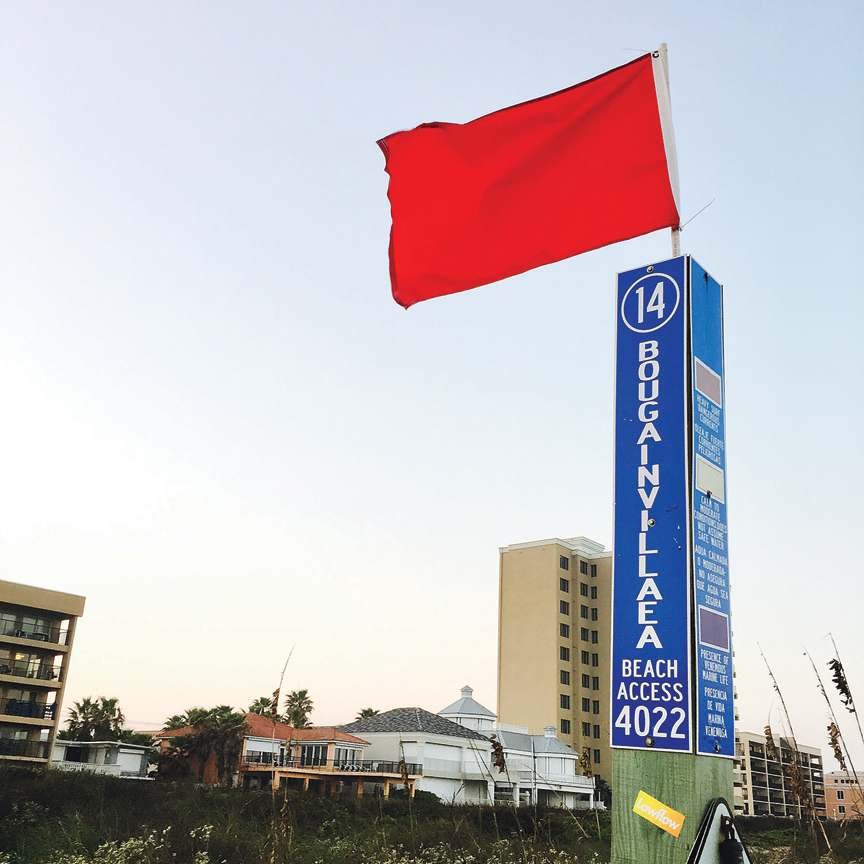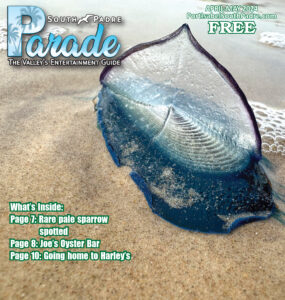By DINA ARÉVALO
Port Isabel-South Padre Press
editor@portisabelsouthpadre.com
You might have seen some flags waving in the breeze at the entrances to the beach here on South Padre Island. Lately they’ve all been a bright shade of crimson, but it’s not because we’re all fans of the color red. The flags mounted to the beach access signs are part of a visual communication scheme meant to let you know at a glance what the water and sand is like that day. So it’s important to know what the various colors mean and how they can alter your plans.
We’ll start with that red flag.
Red means there’s heavy surf and dangerous currents.
Heavy surf is caused by strong winds, while currents are affected by things such as the sandbars just beneath the waves. Don’t go in water that’s higher than your waist, and if you find yourself being pulled out to sea, you’re likely stuck in a rip current. Stay calm and swim parallel to shore. You’ll soon escape the rip current’s pull and be able to swim back to shore.
Purple or blue flags means the potential for pain in the form of jellyfish, Portuguese man-o-wars, stingrays, and other poking or stinging marine life.
If you get stung by a jelly, flag down beach patrol and they’ll be able to help you out in a pinch. And while you’re in the water it’s a good idea to practice the stingray shuffle. Rather than lifting your feet to take each step, drag your feet along the sand. It lets ocean critters know you’re coming and gives them a chance to get out of the way without getting defensive.
Yellow flags mean conditions are normal but you should still exercise caution, just in case. Don’t swim too deep, and stick with your buddies.
There are other things to know about the surf on sunny South Padre, such as how our currents tend to run at an angle from south to north. It’s called the Long Shore Current.
According to the Cameron County Beach Patrol:
The Long Shore Current (also known as the Littoral Current)’s strength and direction are generally determined by wave and wind energy. Look for the Long Shore Current by the angle of the waves coming into shore, by the foam, swimmers and surfers flowing parallel to shore with the Long Shore Current. Always be aware of your surroundings and your position in the water relative to your location on the beach. The Long Shore Current can push swimmers far down the beach, and towards hazards such as piers and rock jetties.
The Long Shore Current can also influence and help create Rip Currents, which present a very deadly danger to swimmers. Be sure to avoid swimming or wading near rock jetties and piers, as Rip Currents often form next to them. See our Rip Currents page for more information.
One last note: if you’ve ever seen the meme about how, in Texas, you can experience all four seasons — winter, spring, summer and fall — in just one day then you already know that things ‘round these parts can change from one hour to the next. The flag warning system is meant to be a guide, and while the local beach patrol is constantly monitoring conditions and changing the flags as often as needed, sometimes Mother Nature changes her mind at too quick a pace to keep up. So, no matter what, always exercise caution on both the beach and in the water.
Want the whole story? Pick up a copy of the Port Isabel-South Padre Press, or subscribe to our E-Edition by clicking here.



Comments